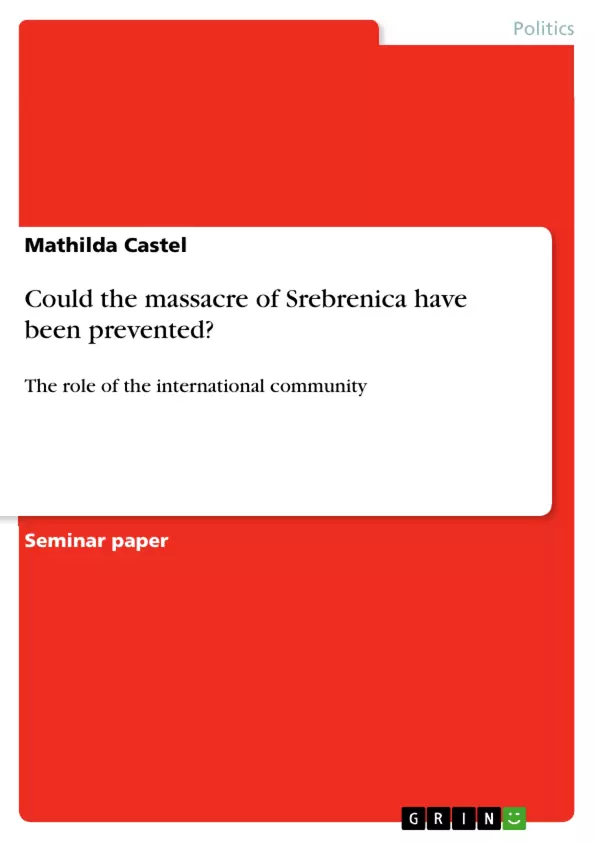This paper will, by considering the events which happened prior to the massacre of Srebrenica and the fact that troops of the United Nations had already been deployed in Bosnia since 1992 and had collected much information, try to give an answer to following question. Could the massacre of Srebrenica have been avoided and what was the role of the international community?
In the attempt of finding a correct answer, the paper will be divided into two parts, the first one answering the question if Srebrenica can even be considered as being a genocide in the correct meaning of the word and the second part being about the avoidance of the tragedy which happened there.
Inhaltsverzeichnis (Table of Contents)
- I. Introduction
- II. Was Srebrenica a genocide?
- 1. A definition of genocide
- 2. The evolution of the term "genocide" since the Second World War
- 3. The Tribunal of The Hague
- 4. Is Srebrenica really a genocide?
- III. Could Srebrenica have been avoided?
- 1. No lessons learned from Rwanda?
- 2. The failing of the UN and the international community
- 3. False promises and small efforts
- IV. Conclusion
Zielsetzung und Themenschwerpunkte (Objectives and Key Themes)
This essay aims to analyze the events surrounding the Srebrenica massacre in 1995 and assess the role of the international community in preventing this tragedy. It delves into the historical context of the Bosnian conflict and examines the definition and evolution of the term "genocide" to determine if Srebrenica qualifies as such. Additionally, the essay investigates whether the massacre could have been avoided, highlighting the failures of the UN and the international community in safeguarding Srebrenica.
- The definition and evolution of the term "genocide"
- The historical context of the Bosnian conflict
- The role of the international community, particularly the UN, in the Bosnian conflict
- The Srebrenica massacre as a potential example of genocide
- The potential for preventing the Srebrenica massacre
Zusammenfassung der Kapitel (Chapter Summaries)
- I. Introduction: The chapter introduces the historical context of Srebrenica, outlining its location within Bosnia and Herzegovina, and emphasizing its tragic role in the Bosnian conflict. It discusses the events that led to the Srebrenica massacre, highlighting the escalating conflict between Bosnian Serbs, Bosnian Muslims, and Bosnian Croats in the 1990s.
- II. Was Srebrenica a genocide?: This chapter delves into the definition of "genocide" and its historical evolution since World War II. It examines the legal framework of genocide through the Genocide Convention and the Rome Statute of the International Criminal Court, highlighting the crucial elements of "intent to destroy" a group and the physical acts involved in committing genocide.
- III. Could Srebrenica have been avoided?: This chapter examines the events leading up to the Srebrenica massacre, focusing on the international community's response, particularly the UN's involvement. It questions whether the massacre could have been prevented, exploring the failures of the UN and the international community in providing adequate protection to the population of Srebrenica.
Schlüsselwörter (Keywords)
The core keywords of this essay include genocide, Srebrenica massacre, Bosnian conflict, international community, UN, UNPROFOR, human rights, humanitarian crisis, legal definition, international law, and war crimes.
- Arbeit zitieren
- Mathilda Castel (Autor:in), 2018, Could the massacre of Srebrenica have been prevented?, München, GRIN Verlag, https://www.grin.com/document/540538



